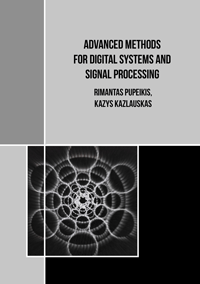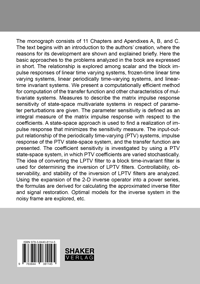
Shop : Details
Shop
Details
19,80 €ISBN 978-3-8440-8114-5Softcover156 pages27 figures231 g21 x 14,8 cmEnglishReference book
July 2021
Rimantas Pupeikis, Kazys Kazlauskas
Advanced methods for digital systems and signal processing
The monograph consists of 11 Chapters and Apendixes A, B, and C. The text begins with an introduction to the authors’ creation, where the reasons for its development are shown and explained briefly. Here the basic approaches to the problems analyzed in the book are expressed in short. The relationship is explored among scalar and the block impulse responses of linear time varying systems, frozen-time linear time varying systems, linear periodically time-varying systems, and linear-time invariant systems. We present a computationally efficient method for computation of the transfer function and other characteristics of multivariate systems. Measures to describe the matrix impulse response sensitivity of state-space multivariate systems in respect of parameter perturbations are given. The parameter sensitivity is defined as an integral measure of the matrix impulse response with respect to the coefficients. A state-space approach is used to find a realization of impulse response that minimizes the sensitivity measure. The input-output relationship of the periodically time-varying (PTV) systems, impulse response of the PTV state-space system, and the transfer function are presented. The coefficient sensitivity is investigated by using a PTV state-space system, in which PTV coefficients are varied stochastically. The idea of converting the LPTV filter to a block time-invariant filter is used for determining the inversion of LPTV filters. Controllability, observability, and stability of the inversion of LPTV filters are analyzed. Using the expansion of the 2-D inverse operator into a power series, the formulas are derived for calculating the approximated inverse filter and signal restoration. Optimal models for the inverse system in the noisy frame are explored, etc.
Keywords: Methods; digital systems; signal processing; impulse response
Available online documents for this title
DOI 10.2370/9783844081145
You need Adobe Reader, to view these files. Here you will find a little help and information for downloading the PDF files.
Please note that the online documents cannot be printed or edited.
Please also see further information at: Help and Information.
Please also see further information at: Help and Information.
| Document |  | Document | ||
| Type |  | |||
| Costs |  | 14,85 € | ||
| Action |  | Purchase in obligation and download the file | ||
| Document |  | Table of contents | ||
| Type |  | |||
| Costs |  | free | ||
| Action |  | Download the file | ||
User settings for registered online customers (online documents)
You can change your address details here and access documents you have already ordered.
User
Not logged in
Export of bibliographic data
Shaker Verlag GmbH
Am Langen Graben 15a
52353 Düren
Germany
Am Langen Graben 15a
52353 Düren
Germany
Mon. - Thurs. 8:00 a.m. to 4:00 p.m.
Fri. 8:00 a.m. to 3:00 p.m.
Fri. 8:00 a.m. to 3:00 p.m.
Contact us. We will be happy to help you.



